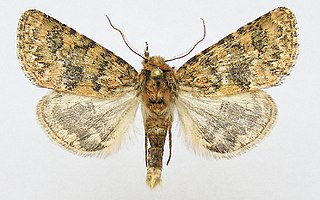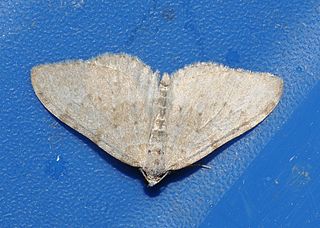Related Research Articles
Epimydia is a monotypic tiger moth genus in the family Erebidae. Its only species, Epimydia dialampra, can be found in mountainous steppe areas in southern Siberia, eastern Yakutia and northern Mongolia. Both the genus and species were first described by Otto Staudinger in 1892. Females are very small and brachypterous.

Victrix is a genus of moths in the family Noctuidae described by Otto Staudinger in 1879. It may be synonymous with the genus Moureia.
Xanthothrix is a genus of moths of the family Noctuidae. The genus was erected by Henry Edwards in 1878.
Antha is a genus of moths of the family Noctuidae. The genus was described by Staudinger in 1892.

Athaumasta is a genus of moths of the family Noctuidae. The genus was erected by George Hampson in 1906.
Aventiola is a monotypic moth genus of the family Erebidae described by Staudinger in 1892. Its only species, Aventiola pusilla, was first described by Arthur Gardiner Butler in 1879. It is found in Japan and south-eastern Siberia.
Bryonycta is a genus of moths of the family Noctuidae. The genus was erected by Charles Boursin in 1955.
Viridemas is a monotypic moth genus of the family Noctuidae. Its only species, Viridemas galena, is found in the US state of Arizona. Both the genus and species were first described by John Bernhardt Smith in 1908.
Gerbathodes is a genus of moths of the family Noctuidae. The genus was described by Warren in 1911.
Hadjina is a genus of moths of the family Noctuidae. The genus was described by Staudinger in 1891.
Hepatica is a genus of moths of the family Noctuidae. The genus was described by Staudinger in 1892.
Paragona is a genus of moths of the family Erebidae. The genus was described by Staudinger in 1892.
Phidrimana is a monotypic moth genus of the family Noctuidae erected by Vladimir S. Kononenko in 1989. Its only species, Phidrimana amurensis, was first described by Staudinger in 1892. It is found in the southern Urals to Amur.
Rhiza is a genus of moths of the family Noctuidae. The genus was described by Staudinger in 1889.
Stemmaphora is a monotypic moth genus of the family Noctuidae. Its only species, Stemmaphora viola, is found in Turkmenistan, Crimea and Uzbekistan. Both the genus and species were first described by Staudinger in 1888.

Gynaephora is a genus of "tussock moths", also known as the Lymantriinae, within the family Erebidae. They are mainly found in the Holarctic in alpine, Arctic and Subarctic regions, and are best known for their unusually long larval development period. The life-cycle of Gynaephora groenlandica was once believed to take fourteen years, but subsequent studies reduced it to seven, still a very slow development rate that is extremely rare in the Lepidoptera. The caterpillars have five instars, with each instar lasting a year.
Ocnerogyia is a monotypic moth genus in the subfamily Lymantriinae. Its only species, Ocnerogyia amanda, is found in Iran. Both the genus and the species were first described by Staudinger in 1892.
Parocneria is a genus of tussock moths in the family Erebidae. The genus was erected by Harrison Gray Dyar Jr. in 1897.
Dasypteroma is a monotypic moth genus in the family Geometridae. Its only species, Dasypteroma thaumasia, is found in Spain. Both the genus and species were first described by Otto Staudinger in 1892.

Nebula is a genus of moths in the family Geometridae erected by Charles Théophile Bruand d'Uzelle in 1846.
References
- ↑ Beccaloni, G.; Scoble, M.; Kitching, I.; Simonsen, T.; Robinson, G.; Pitkin, B.; Hine, A.; Lyal, C., eds. (2003). "Bryomoia". The Global Lepidoptera Names Index . Natural History Museum . Retrieved January 6, 2021.
- ↑ Savela, Markku (April 14, 2020). "Bryomoia Staudinger, 1892". Lepidoptera and Some Other Life Forms. Retrieved January 6, 2021.
- ↑ Pitkin, Brian & Jenkins, Paul (November 5, 2004). "Bryomoia Staudinger, 1892". Butterflies and Moths of the World. Natural History Museum, London . Retrieved January 6, 2021.
| This Hadeninae-related article is a stub. You can help Wikipedia by expanding it. |